#Continuing Professional Education Texas
Audio
This 3-hour course is designed to meet the 3-hour Ethics CPE requirement for Ohio CPAs. It provides an overview of ethical thought along with the core values of the CPA profession.
#Ohio Ethics#American Center for Continuing Professional Education#Accounting CPE | American Center For Continuing Professional Education | ACCPE#ACCPE#Ohio Ethics Texas#Continuing Professional Education for CPAs Texas#Continuing Education Texas#CPE Texas#Continuing Professional Education Texas#Continuing Education for Accountants Texas#CPA Including Consulting Services CPE#CPA Including Auditing CPE#CPA Including CPE For Accounting#Continuing Education For CPAs Ohio | Texas | New York | North Carolina#Continuing Education for Accountants Ohio | Texas | New York | North Carolina#Current Developments Accounting and Financial in Texas
0 notes
Photo
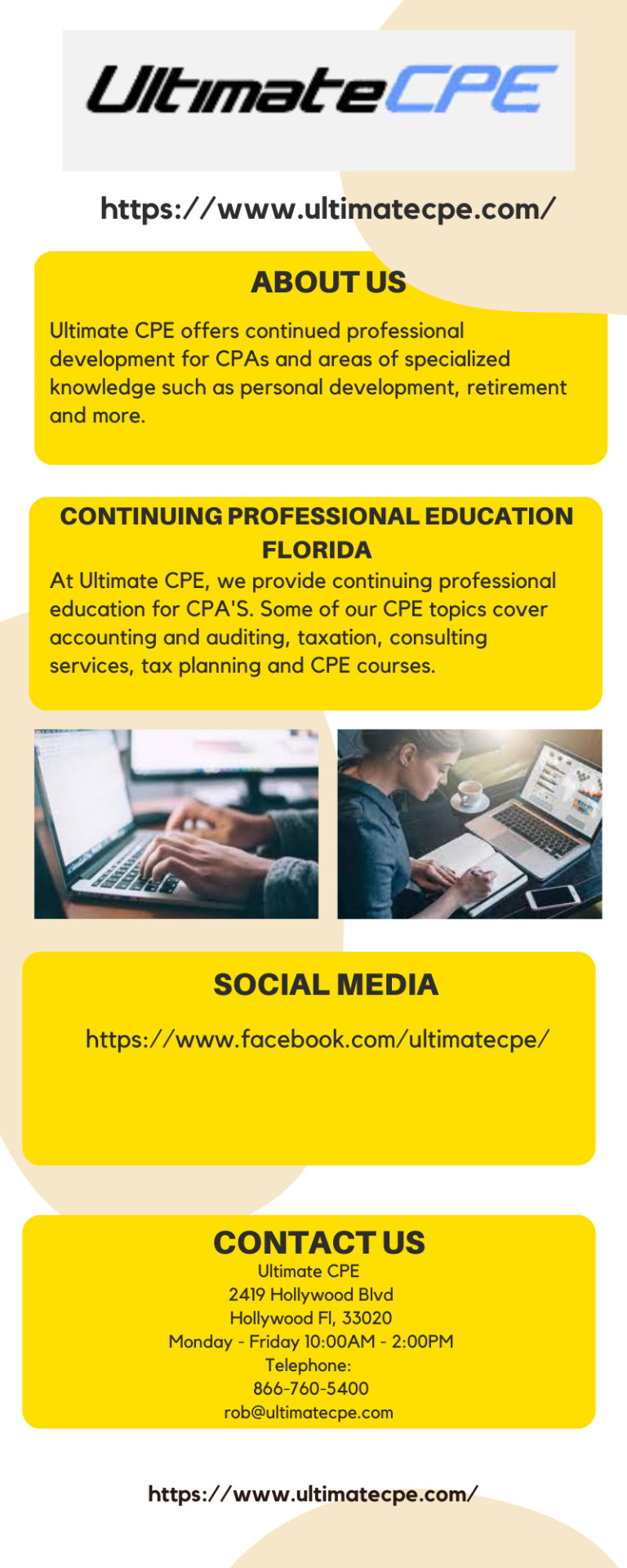
At Ultimate CPE, we provide continuing professional education for CPA'S. Some of our CPE topics cover accounting and auditing, taxation, consulting services, tax planning and CPE courses.
#Continuing Professional Education#Self-Study CPE Courses#Continuing Professional Education | Self-Study CPE Courses | Ultimate CPE#Ultimate CPE#Continuing Professional Education Florida#Online CPE Courses for CPE Florida#Florida CPA Ethics Courses#Taxation-Self-Study CPE Courses#Accounting CPE Courses Florida#CPA CPE Courses Florida#Accounting Education for CPA Florida#Tax and Accounting CPE Courses#Continuing Professional Education For CPAs#Accounting Continuing Education Courses Online#Accounting Continuing Education Florida#GAAP GAAS & SSARS Courses Texas#GAAP Florida#Government CPE Florida#GAAS Florida#GAAS in Florida
0 notes
Text
Daniel Villarreal at LGBTQ Nation:
A completed draft Texas Republican Party platform refers to homosexuality as “an abnormal lifestyle choice,” gender-affirming care as “child abuse,” and Drag Queen Story Hour as “predatory sexual behavior.” The platform has been voted on by state party delegates and will be formally adopted on Wednesday after a final vote count.
The list of state party priorities calls for an end to legal same-sex marriages, same-sex parenting, all LGBTQ+ anti-discrimination laws, all transgender rights — including gender-affirming care for children and adults — a ban on LGBTQ+ content in schools and libraries, the defunding of all diversity-equity-inclusion (DEI) initiatives, and legal protections for anyone who discriminates against queer people based on “religious or moral beliefs.”
Furthermore, the Texas GOP platform calls for a complete end to all of the following: pornography, federal welfare programs, minimum wage laws, mandatory sick or family leave policies, net neutrality, removal of Confederate monuments, pro-immigrant sanctuary cities, public education of undocumented children, no-fault divorce, non-abstinence sex education, abortion, birthright citizenship, professorial tenure in colleges and universities, cannabis legalization, anti-climate change legislation, contact tracing for the tracking of communicable diseases, federal regulations ensuring safe farm food production, and U.S. participation in the United Nations and North Atlantic Treaty Organization (NATO).
The platform also calls for fertilized human egg cells to be legally recognized as people, the passage of a “state electoral college-style” law that would make it nearly impossible for Democrats to win statewide office, a ballot measure for Texas to secede from the United States, the invalidation of all federal laws not approved of by county sheriffs, and for Christianity to be inserted into public schools and government buildings.
[...]
“Homosexuality is an abnormal lifestyle choice,” it continues. “No one should be granted special legal status based on their LGBTQ+ identification…. We are opposed to same-sex parenting, intentionally subjecting a child to the loss of their biological father or mother, and other non-traditional definitions of family.”
“We oppose all efforts to validate transgender identity,” it adds. “There shall be no attempt to engage in so-called ‘gender affirming’ medical or mental health intervention for persons between the ages of 18 and 26,” including the use of names and pronouns associated with trans people’s genders. The platform would require health insurance companies covering gender-affirming care to also fully fund de-transitional procedures.
The platform says that any professionals who aid a minor’s gender transition in any way should face professional, civil, and criminal penalties, as well as lawsuits from anyone affected by their behavior. Furthermore, it calls for all gender-segregated facilities in prisons, schools, and government buildings to only be accessible to people based on their biological sex assigned at birth.
[...]
It also calls for laws prohibiting the exposure of minors to “social transitioning” (that is, exploration of a gender other than the one they were assigned at birth), “predatory sexual behaviors” like Drag Queen Story Hour, and “the desensitization of children to sexual topics.”
The Texas GOP's platform reaffirms and expands its war on LGBTQ+ Texans, such as including anti-LGBTQ+, anti-trans, and anti-drag planks like baselessly calling Drag Queen Story Hours "predatory sexual behaviors" and gender-affirming care "child abuse".
This is in addition to calling homosexuality "an abnormal lifestyle choice" (a bigoted dogwhistle term used against recognizing LGBTQ+ identity) and opposing trans identity.
#Texas GOP#Texas#Anti LGBTQ+ Extremism#Anti Trans Extremism#Anti Drag Show Extremism#Dragphobia#Transphobia#Homophobia#LGBTQ+#Drag#Transgender#Gender Affirming Healthcare#Drag Queen Story Hour#Social Transition#Transgender Erasure#Detransition
35 notes
·
View notes
Text
William Hootkins in the 1970s.

William Hootkins was born in Texas in 1948. He was active in theater in High School and at Princeton University and interested in becoming a professional actor after graduating. His his friend John Lithgow recommended he move to England to continue his acting education, probably because he knew he'd get greater opportunities. So he moved to England in the 1970s and trained at The London Academy of Music and Dramatic Art. He continued mainly in theater and took film roles when he could. His first film role was a small role as a henchman in the British R rated film, Big Zapper in 1973.


Big Zapper, 1973. Small role and Hootkins would've been 24-25 years old during filming.

Anthology series Plays for Britain. Hootkins gets a small role in the episode The Paradise Run in 1976.


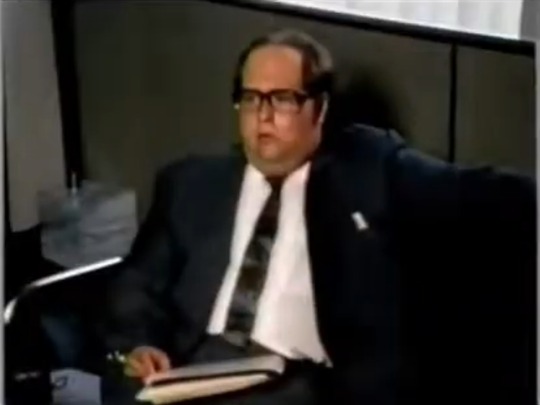

An anthology Documentary series, Horizon, which featured film adaptations of real-life events. Hootkins had a greater role in this 1976 offering Billion Dollar Bubble which starred James Woods about Insurance Company fraud in the early years of computers.


Still in his 20s, Hootkins got a small role in a major American film directed by Robert Aldrich and the opportunity to share a scene with Charles Durning, Twilight's Last Gleaming in 1977.



Also in 1977, Hootkins played Porkins in a small role in the 1977 blockbuster Star Wars. Small role but big enough to get his own action figure.
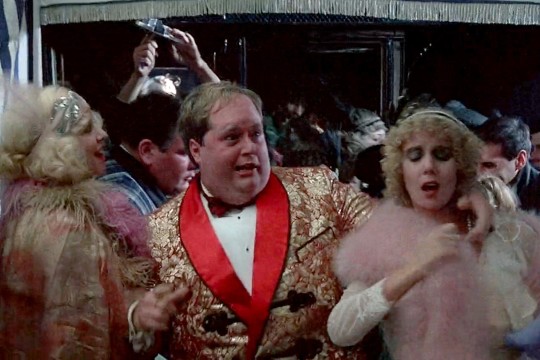
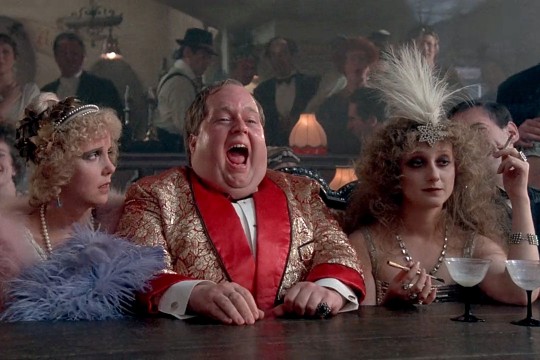
And again in 1977, Hootkins worked with Director Ken Russell in Valentino in a high energy scene of a drunken, egotistical silent film star. The movie was a bomb mainly because it wasn't the biopic of Rudolph Valentino that people expected. Russell took too much license in the life of Valentino to tell a more interesting story. I think what was known of the real lives of stars back then was greatly what the studio wanted to present to the public. So I think Russell was justified.
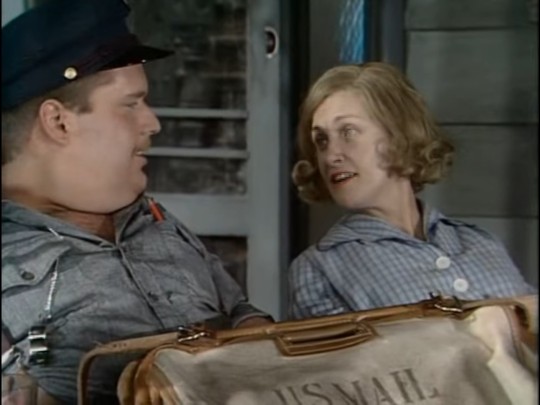

1977 was an especially good year for William Hootkins. The above photos are from a US-UK collaboration of a teleplay version of Come Back, Little Sheba starring Laurence Olivier and Joanne Woodward. Hootkins is in one scene only. Also in 1977, Hootkins appeared in episodes of British TV series, Van der Volk, Yanks Go Home, Plum's Plots and Plans and Documentary Series, The Lively Arts.
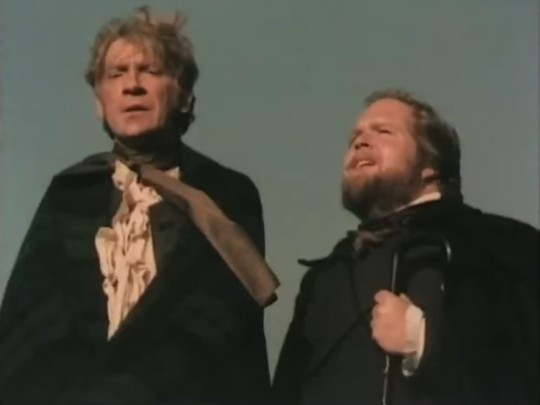

In 1978. Hootkins appeared in Part 1 of Clouds of Glory, a 2-part series of the lives of Poets, William Wordsworth and Samuel T Coleridge. Hootkins appeared with David Warner.
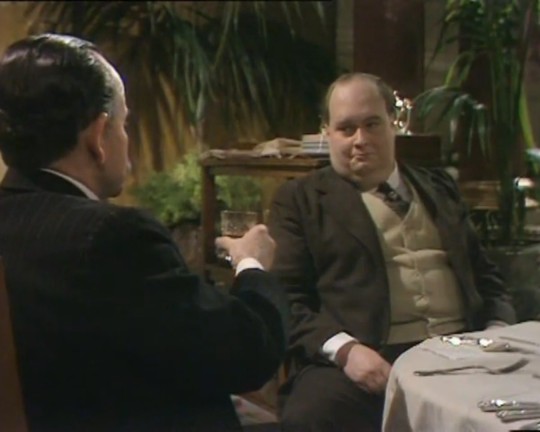

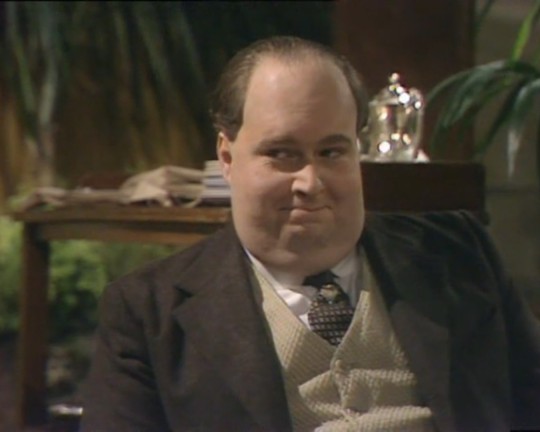
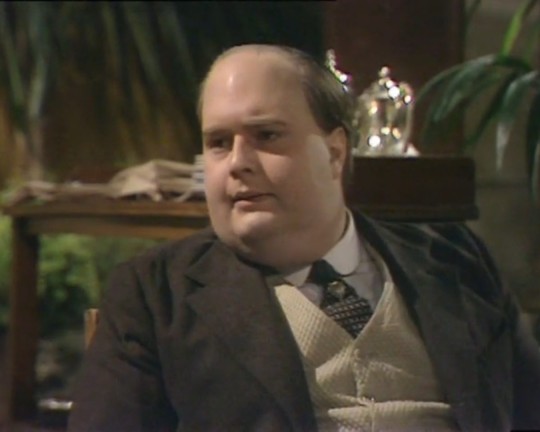
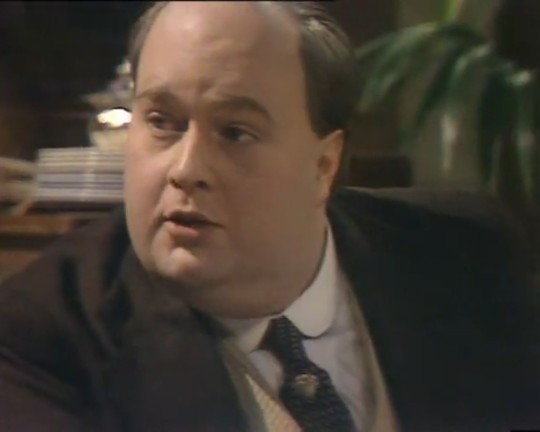
Late 1978, now William Hootkins is 30 years old and no denying the hair loss. He appears in all 3 episodes of the British miniseries The Lost Boys, about Peter Pan writer J. M. Barrie starring Ian Holm, presenting Barrie as homosexual and a pedophile (at least only in his mind). Hootkins plays Barrie's American friend, Broadway and London Theater Producer Charles Frohman.
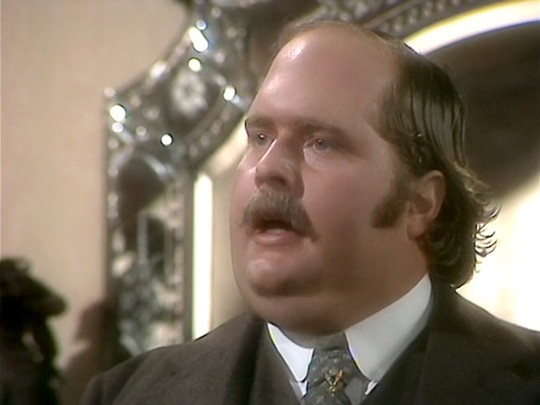

Hootkins appeared in one episode of British 13-part miniseries Lillie, the story of Lillie Langtry in 1978.

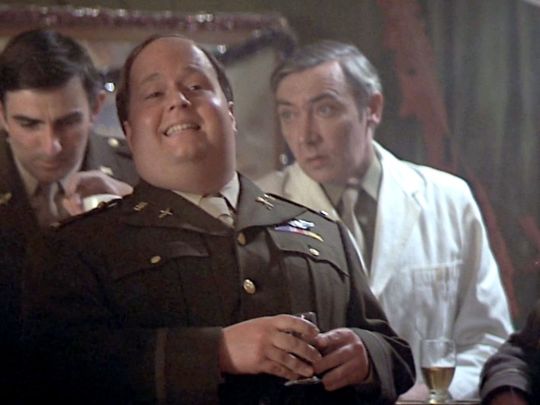
In 1979, Hootkins appeared in Hanover Street as Beef with Harrison Ford.

Also in 1979, he played a very small role in a remake of The Lady Vanishes with Cybill Shepherd and Angela Lansbury.
36 notes
·
View notes
Text
San Antonio Workplace Organizing Committee to support local union efforts
By Josh Peck

The San Antonio chapter of the Democratic Socialists of America (DSA) voted last week to establish the San Antonio Workplace Organizing Committee (SAWOC), which supporters said will serve as a local hub to help workers form unions in their workplaces.
SAWOC is a local chapter of the Emergency Workplace Organizing Committee (EWOC), a volunteer-based organization which was established in 2020. It aims to help workers around the country form unions because the possibility for in-person organizing was diminished by the COVID-19 pandemic. It was created through a collaboration between the national DSA and the United Electrical, Radio, and Machine Workers of America.
Alex Birnel, a former co-chair of San Antonio DSA and one of the authors of the SAWOC resolution, said the EWOC model provides more capacity to organize workers that many large unions don’t currently have.
“EWOC was a way of bridging the gap between appetite for unions and the inability of some of the bigger unions to bring on new drives, organizing in a traditional fashion with traditional tactics and traditional strategy,” he said.
A UT Austin Texas Politics Poll from December 2023 found that 64% of Texans believe unions are good for workers, but only 3.2% of workers in the private sector and 19.3% of workers in the public sector were in unions last year.

Despite the large coffers of major unions, according to labor union researcher and activist Chris Bohner, union organizing staff have declined over the last few decades, and only a handful of unions — like the United Auto Workers — are aggressively organizing new workers.
Birnel explained why San Antonio DSA decided to create their own local version of EWOC.
“The cool thing about localizing the EWOC model is it allows you to work with your local union community and build more relationships with union organizers — people that know how to form unions, how to help workers do everything from map their workplace to prepare for a contact campaign — to connect those folks with the existing labor community and all the organs of that community,” he said.
Alejandra Lopez is another co-author of the SAWOC resolution, the first vice president in the San Antonio AFL-CIO Central Labor Council, and the president of San Antonio Alliance, the union representing San Antonio Independent School District educators and support workers.
Lopez said the San Antonio AFL-CIO passed a resolution last week that supported the SAWOC and appointed a liaison to maintain communication between SAWOC and the San Antonio AFL-CIO.
“We want to ensure that there’s a strong relationship between the people who are being plugged in through the EWOC program and the organized, established labor locals here in the city, because we’re only going to build worker power by bringing all of those different groups of people together,” Lopez said.

She said the ultimate dynamic between SAWOC and the San Antonio AFL-CIO will become clearer as communication between the two groups continues, but that step one is education about what SAWOC can be.
“We want to ensure that the Central Labor Council knows what the project is, what the positive impacts of this project will be, and how necessary this project is to continuing to build worker power in the city,” she said.
One possible route for the partnership is financial support for SAWOC from the local union federation to professionalize the organizing efforts.
“EWOC is, in its inception [and] almost on purpose, a volunteer-led effort,” Birnel said. “But with more resources, you can put together locally branded materials that have the endorsements of all the local unions on it. And this is for the formation of a common identity here locally. … It can also allow for things like scalability, where if you need to rent rooms at the public library to do trainings — things like this — it can make doing in person EWOC trainings a possibility.”
He added that SAWOC was still just getting off the ground, but that because the world of labor organizing goes beyond pay levels and layoff protections, political education will also be key to its operations.
“Oftentimes when someone is union-interested or union-curious, and they start to take the first steps of forming a union, they find themselves in a world with a ton of new vocabulary, a ton of new agencies that are relevant to think about, a ton of new ways of thinking around organizing politically, acting strategically,” Birnel said. “Not only in the confines of their particular campaign, but how do they fit in as part of the landscape?”
He said the next task for SAWOC is to establish its training materials and to build a volunteer base.
5 notes
·
View notes
Text
Even More BOD Headcanons
Because I love them x3.
Kane is an empath, but he's also a sadist. Which means when he feels an opponent's fear, all it does is excite him.
Taker was adopted by a couple from Houston, Texas, after the fire. During his first few months with them, he had violent nightmares and episodes of sleepwalking. During the worst of these episodes, he wandered into the garage, poured gasoline all over himself, and tried to light himself on fire before being stopped and woken up just in time by his foster parents.
Altogether, Kane spent approximately seventeen or eighteen years of his backstory locked up in Paul's basement and the remaining two or three years in a hospital or mental institution.
Kane has had asthma ever since he was a little kid. He continues to smoke in spite of this because he's a self-destructive shit.
Taker was physically abused by his father, a violent alcoholic, as a child. He often took beatings for his mother and baby brother. To this day, he's in denial that what he experienced was abuse, despite the fact that he can easily look at someone else experiencing what he did and recognize it as abusive.
Taker is a carbon copy of his father in terms of his physical appearance with the exception of his coloration, which he gets from his mother.
Kane was born at the same time as his maternal grandmother died.
Kane's night vision and depth perception both suck on account of him only having one working eye.
Kane is allergic to peanuts.
Both brothers are bisexual. Taker generally prefers men while Kane generally prefers women.
Taker's type, regardless of whether his love interest is male or female, can be summed up with the three Bs: "blond," "bimbo," "Barbie." Kane doesn't have a type when it comes to women, but when it comes to men, he prefers guys who are significantly smaller than he is.
Kane's favorite band is Slipknot. Taker is partial to Johnny Cash.
Kane is 100% the mom friend.
Taker wasn't initially very excited to be a big brother, worried that the new baby would take up all of his mother's love and attention. When Kane was born, however, Taker was the second person to ever hold him, and little baby Kane looked directly into his eyes and grabbed one of his fingers with his tiny hand. In that moment, Taker fell in love and willingly became his brother's keeper.
Kane loves chocolate. He has a bit of a pocky problem.
As a result of being chronically malnourished and occasionally deprived of food entirely by his father growing up, Kane hoards food well into adulthood. He also dislikes eating around other people, as it makes him anxious with the thought that someone is going to steal his food.
Taker was a bit of a party animal in his younger years. He was actually known as "PartyTaker" backstage at one point; that's how active he was. He's older now, but he still occasionally tries to live up to his old reputation.
Kane never went to school. He has absolutely zero formal education.
Taker is a college dropout. He decided partway through his degree program that he wanted to be a professional athlete.
When they occupy the same space, the brothers constantly argue over who gets control of the TV. Taker wants to watch MMA; Kane wants to watch the Food Network. They will get into physical altercations over the remote.
Kane is a slow reader, but he loves reading nevertheless. He always has a book on hand.
Kane is a horror movie buff. When he watches slasher movies, he almost always roots for the bad guy.
5 notes
·
View notes
Text
Enchanting Elegance Exploring the City Ballet of Houston
Houston, Texas, a city known for its vibrant culture, diverse population, and dynamic arts scene, is home to one of the most captivating treasures of the ballet world: the City Ballet of Houston. Established with a mission to inspire, educate, and entertain audiences through the artistry of dance, this renowned company has been enchanting audiences for years with its grace, precision, and unparalleled performances.

Founded by visionary artistic director, Sarah Johnson, the City Ballet of Houston has emerged as a beacon of excellence in the ballet community. Under Johnson's leadership, the company has garnered acclaim for its innovative repertoire, commitment to artistic integrity, and dedication to nurturing emerging talent.
At the heart of the City Ballet of Houston's success lies its unwavering dedication to artistic excellence. With a roster of world-class dancers hailing from diverse backgrounds and training traditions, the company embodies a rich tapestry of styles and influences, seamlessly blending classical technique with contemporary flair. From timeless classics like Swan Lake and The Nutcracker to cutting-edge contemporary works, each performance is a testament to the company's commitment to pushing the boundaries of artistic expression.
Central to the City Ballet of Houston's artistic vision is its commitment to fostering the next generation of dancers and choreographers. Through its comprehensive education and outreach programs, the company provides aspiring young artists with access to world-class training, mentorship, and performance opportunities. From community workshops and school residencies to pre-professional training programs, the City Ballet of Houston is dedicated to nurturing the talents of tomorrow's dance stars.
One of the hallmarks of the City Ballet of Houston's programming is its commitment to diversity and inclusion. Recognizing the transformative power of dance to unite people across cultures and communities, the company actively seeks to reflect the rich tapestry of Houston's population on stage. Through collaborations with local artists, choreographers, and musicians, the company celebrates the diversity of the human experience, creating performances that resonate with audiences of all backgrounds.
Beyond its performances on stage, the City Ballet of Houston is deeply invested in enriching the cultural fabric of the Houston community. Through partnerships with schools, community centers, and cultural organizations, the company brings the joy of dance to audiences of all ages and backgrounds. From free performances in public spaces to interactive workshops and masterclasses, the City Ballet of Houston is committed to making the transformative power of dance accessible to all.
As the City Ballet of Houston continues to captivate audiences with its mesmerizing performances and commitment to artistic excellence, its impact extends far beyond the stage. Through its dedication to education, outreach, and community engagement, the company is shaping the future of dance in Houston and beyond, inspiring generations of artists and audiences alike to dream, create, and connect through the beauty of ballet.
In a city renowned for its diversity, dynamism, and cultural vibrancy, the City Ballet of Houston stands as a shining example of artistic excellence and innovation. With its enchanting performances, commitment to education, and dedication to inclusion, the company continues to inspire, uplift, and delight audiences around the world, proving that the power of dance knows no bounds.
For more info:-
CITY BALLET OF HOUSTON
3 notes
·
View notes
Photo

Do your homework to prep for the 2023 and 2024 eclipses This year and next, Americans will have the extraordinary opportunity to witness two solar eclipses as both will be visible throughout the continental U.S. On Oct. 14, 2023, the moon will obscure all but a small annulus of the sun, producing a “ring of fire” eclipse. On April 8, 2024, the eclipse will be total in a band stretching from Texas to Maine. Both occurrences promise to be remarkable events and teachable moments. But preparation is essential. In The Physics Teacher, co-published by AIP Publishing and the American Association of Physics Teachers, astronomer Douglas Duncan of the University of Colorado provides a practical playbook to help teachers, students, and the general public prepare for the eclipse events. He also shares ways to fundraise for schools and organizations and guidance for safe eclipse-viewing. The Fiske Planetarium, which Duncan used to direct, is also producing short videos about the upcoming eclipses. “According to NASA surveys, over 100 million Americans watched the 2017 eclipse in person or via media,” said Duncan. “That was when a total eclipse crossed the U.S., with totality viewable in Wyoming, where Motel 6 rooms in the state were going for $800 a night if you didn’t book far in advance. A total eclipse is worth traveling to. It is incredible, and people remember it their whole life.” A self-described eclipse-chaser who has himself witnessed 12 eclipses beginning in 1970, Duncan emphasizes the importance of eye protection. He cites two companies that produce inexpensive glasses for viewing the sun and advises event organizers to order them well in advance: Solar Eclipse Glasses and Rainbow Symphony. Additionally, after observing spectators at previous eclipses using their phones to snap pictures, Duncan developed Solar Snap, a filter and app to enable safe and effective smart phone photography for such events. With small groups, Duncan suggests using binoculars to project an image of the sun so that viewers can safely observe the spectacle transposed onto a sheet of paper. Duncan’s paper is, above all, a rallying cry. “Organizing, spreading the word, and planning ahead will be key to making the most of these events,” said Duncan. “If you’re a student, talk to your teachers or principal. If you’re organizing a large viewing event, think about the various logistics. Much of the onus is on us – teachers, students, communities.” ### The article “Prepare for the 2023-2024 solar eclipses: School and community events, and fundraising” is authored by Douglas Duncan. The article appears in The Physics Teacher on May 1, 2023 (DOI: 10.1119/5.0131185) and can be accessed at https://doi.org/10.1119/5.0131185. Disclosure: As stated in the manuscript, the author is the inventor (and patent holder) of the Solar Snap device that allows phones to photograph the sun. He acknowledges receiving a royalty from the factory whenever this item is sold. The factory sells it to stores, libraries, schools, and individuals. ABOUT THE JOURNAL Dedicated to the strengthening of the teaching of introductory physics at all levels, The Physics Teacher includes tutorial papers, articles on pedagogy, current research, and news in physics, as well as history, philosophy, and biography. Notes cover classroom techniques, and columns feature demonstration apparatus and book and film reviews. See https://aapt.scitation.org/journal/pte. ABOUT AAPT AAPT is an international organization for physics educators, physicists, and industrial scientists with members worldwide. Dedicated to enhancing the understanding and appreciation of physics through teaching, AAPT provides awards, publications, and programs that encourage teaching practical application of physics principles, support continuing professional development, and reward excellence in physics education. AAPT was founded in 1930 and is headquartered in the American Center for Physics in College Park, Maryland. ### IMAGE....2017 total eclipse CREDIT Miloslav Druckmüller, Marcel Bělík, Radovan Mrllák, Shadia Habbal
10 notes
·
View notes
Text
A Bay Area OB-GYN is organizing an effort to bring abortion services and reproductive healthcare to several southern states bordering the Gulf of Mexico via a ship sailing on federal waters.
Dr. Meg Autry, who also works as a professor at UCSF, had already been working to bring this effort to life. But when Roe v. Wade was overturned, Autry said their plans were accelerated.
As first reported by KCBS, this plan called Protecting Reproductive Rights of Women Endangered by State Statutes (PRROWESS) aims to bring reproductive healthcare to states where abortions are banned, limited, or hard to access.
In an interview with NBC Bay Area, Autry noted that people living in southern parts of states with restrictive abortion rules like Texas and Louisiana, are actually closer to the coast than to nearby states with more abortion access. Additionally, it is less expensive to board a boat than buying a plane ticket to another state.
Autry has performed abortions for decades and refers to herself as "a lifelong educator, a lifelong career abortion advocate."
"It is my life’s work," she said.
"Part of the reason we’re working on this project so hard is because wealthy people in our country are always going to have access [to abortions], so once again it’s a time now where poor, people of color, marginalized individuals, are gonna suffer --and by suffering I mean like lives lost," Autry said.
She explained that this ship will operate on federal waters — nine miles from the coast of Texas and three from the coast of Alabama, Louisiana and Mississippi — where it can evade those states' abortion restrictions. PRROWESS will arrange for patients to be transported to the ship, which will vary depending on where they are coming from, once they pass a pre-screening process.
Autry and a team of licensed medical professionals will offer surgical abortions for up to 14 weeks of pregnancy. The PRROWESS team would also offer other point-of-care gynecological services such as testing and treatment for sexually transmitted infections.
"The project is being funded with philanthropy and the patients care is on a needs basis, so most individuals will pay little to nothing for services," Autry said.
Stacy Cross, president of Planned Parenthood Mar Monte, which offers services in California and Nevada, said it's not surprising that health care providers are teaming up to offer services on the seas.
Cross explained that the abortion service provider community has been preparing for the possibility of a post-Roe world for some time now and that, "over the years we’ve talked about things like boats on federal waters out past the 5-mile line."
"It's just it’s a testament to the time we’re in, because its really horrific that we’re having to think of these things in the United States of America, how to keep people safe," Cross said.
Several California Planned Parenthood chapters told NBC Bay Area that demand from out-of-state patients at California clinics has actually been up for months already due to policies in other states.
“I think people are going to be as creative as possible, the people who have the funds are getting on planes and flying, we’re seeing other people drive here,” Cross said.
Autry's organization is still raising money to secure a ship and retrofit it for medical use. Once that happens, she says they'll put the captain, crew and medical team aboard and set sail.
Autry and her team maintain the process is legal in federal waters. Still, they expect legal challenges from those states every step of the way. The PRROWESS team has already tapped multiple lawyers to help them as they continue with this voyage.
#us politics#news#nbc news#nbc bay area#abortions#abortion bans#federal waters#Gulf of Mexico#Dr. Meg Autry#roe v. wade#kcbs#Protecting Reproductive Rights of Women Endangered by State Statutes#PRROWESS#Stacy Cross#planned parenthood#reproductive health#reproductive rights#reproductive rights are human rights#abortion is a class issue#abortion is health care#abortion is a human right#abortion is better than negligence#2022#bans off my body
92 notes
·
View notes
Text

Mary Cauleen (Bawks, Howell) Galer, age 93, of Pickford, Michigan, died peacefully at MyMichigan Medical Center in Sault Ste. Marie, Michigan, on March 2, 2023. She was born at home in Pickford, Michigan, on April 5, 1929, to Robert Orville and Della Jane (McDowell) Bawks.
Mary was passionate about education throughout her life. After graduating from Pickford High School in 1947, she began her higher education studies at Bob Jones University, where she met and fell in love with fellow educator Sandy Howell. They were married in Pickford on June 9, 1951. She continued her education at Western Michigan University, earning a bachelor's degree in science. She continued studies at Ferris State University, Northern Michigan University, and Michigan State University. Mary began teaching at Parkerville School, a one room schoolhouse in Bruce Township, Michigan, and retired as Principal of Pickford Elementary School after an illustrious 41 year career.
After they both lost their first spouses, Mary and Willis Galer fell in love and eloped to Maui, Hawaii on September 20, 1995. They enjoyed 20 years of traveling and adventure together, often with her best friend Dorthea and her husband Ragan Callaway and Bill and Norma Raynard.
Mary's faith was an integral part of her life. She was a lifelong member of the United Methodist Church in Pickford. She volunteered as a Sunday School teacher and was the Choir and Cantatas Director for 27 years. Mary enjoyed the musical arts outside of church as well. She sang with music groups Vocal Majority and the Mary Wood Chorus, and she was an accomplished clarinetist and organist.
Mary joined Delta Kappa Gamma International for Women Educators in 1960 and served as a chapter and state officer. She was awarded the Delta Kappa Gamma Woman of Distinction award in 1976. She was a member of the Pickford Grange and served in several positions including officer, flora, and chaplain. Mary was awarded the Woman of the Year award in 1983 by the Business and Professional Women organization. She was also a member of the Michigan Elementary and Middle School Principal's Association.
Mary was an animal lover and had seven beloved Boston Terrier companions throughout her life.
Mary is survived by her nephew, Charles (Jenni) Bawks of White Oak, Texas; niece, Aleta (Dan) Phelps of Euless, Texas; great nephews, Russell (Kristen) Bawks, Stephen (Jennifer) Phelps, Michael (Manuela) Phelps, and Timothy Phelps; and 6 great-great nieces and nephews; stepdaughter, Linda (David) Thompson of Pickford; stepson, Rod (Patsy) Galer of Pickford; grandchildren, Candace (Larry) Warner, Cheri (Scott) Skinner, Trisha (Zac) Jennings, Micah (Lisa) Galer, Nathan (Tiffany) Galer, and Emily Galer; 16 great grandchildren; and 4 great-great grandchildren. She is also survived by her sisters-in-law, Edith Howell Pfoutz and Lorraine Galer, and brother-in-law, Paul VanLuven.
Mary was preceded in death by her husbands, Robert Howell and Willis Galer; her parents, Robert Orville and Della; her brother, Alvin Bawks; and her great nephew, Matthew Bawks.
Services will be held Monday, April 10, 2023, at the Pickford Methodist Church. Visitation will be from 11:00 AM until 1:00 PM with the funeral service beginning at 1:00 PM. Burial will be in Oaklawn Chapel Gardens in Bruce Township, Michigan.
Galer Funeral Home & Cremation of Pickford, Michigan, is serving the family. Condolences may be left to the family at www.galerfuneralhomes.com.
#Bob Jones University#BJU Hall of Fame#Obituary#BJU Alumni Association#2023#Mary Cauleen Bawks Howell Galer#Class of 1949
2 notes
·
View notes
Text
“That a certain segment of the internet would be so hungry for even a fleeting glimpse of Malick is not surprising. The director is as famous for his closely guarded privacy as his output. He has not given an on-the-record interview in nearly four decades. From 1978, when Paramount released Malick’s second film, the Panhandle-set Days of Heaven, until 1998, when his World War II epic, The Thin Red Line, premiered, Malick more or less vanished. Rumors circulated around Hollywood that he was living in a garage, that he was teaching philosophy at the Sorbonne, that he was working as a hairdresser. Even as he returned to filmmaking, was nominated for Oscars, won the Cannes Film Festival’s Palm d’Or, and doubled down on his experimental style (cinephiles will never stop debating his decision to punctuate a fifties Texas family drama with CGI dinosaurs in The Tree of Life), Malick continued to maintain his silence.
(…)
Malick was born in Illinois in 1943 and spent his boyhood mostly in Waco and Bartlesville, Oklahoma, the eldest of three brothers. His mother, Irene, was a homemaker who had grown up on a farm near Chicago; his father, Emil, was the son of Assyrian Christians from Urmia, in what is now modern-day Iran, and staked out a career as an executive with the Phillips Petroleum Company. Emil was aggressively accomplished, a multi-patent-holding geologist who played professional-level church organ and served as a choir director, and he pushed the young Malick to succeed on all fronts from an early age. (A Waco Tribune-Herald news brief from 1952 noted that “eight-year-old Terry” had “surprised his classmates at Lake Waco Elementary School by presenting a 43-page paper on planets.”) But Emil could be a stern taskmaster, and he and Malick often butted heads. “They had some conflicts over the years,” Jim Lynch, a close friend of Malick’s since high school, told me. “That’s one reason Terry came to St. Stephen’s.”
St. Stephen’s is known as the Hill, both for its steep topography and its aspiration to be an enlightened beacon (as in the biblical “city on a hill”), and Malick thrived in a culture that emphasized spirituality, intellectualism, and rugged individualism. “When I first got there, it was made known that he was the local genius,” Lynch told me. Malick had the highest standing in the class his junior and senior years, served in student leadership positions like dorm council, played forward on the basketball team, and, with Romberg, co-captained the football team, playing both offensive and defensive tackle, an accomplishment of which he’s still proud. (“He says that in football he was ‘the sixty-minute man,’ ” Linklater told me. “Ecky says that the only time he boasts is when he talks about his high school athletic prowess.”)
None of Malick’s peers—or, it would seem, Malick—had any inkling that he would stake out a career as a filmmaker, but he was already exploring many of the ideas that would animate his work. Students at St. Stephen’s went to chapel twice a day, and the spiritual education there was both rigorous and open-minded, with The Catcher in the Rye taught alongside more traditional religious texts in the school’s Christian ethics class. “It was religious in a broad humanities sense,” Lynch said, a conception that Malick embraced. “Terry doesn’t like anything sectarian or dogmatic,” Lynch added. “His grounding is more in a philosophical sense of wonder.”
(…)
After Harvard and a Rhodes Scholarship at Oxford University, Malick began experimenting with more-white-collar careers. He worked for a short time as a globe-trotting magazine journalist, interviewing Haitian dictator “Papa Doc” Duvalier and spending four months in Bolivia reporting for the New Yorker on the trial of the French philosopher Régis Debray, who had been accused of supporting Che Guevara and his Marxist revolutionary forces. (Malick never completed the piece.) Then there was a year as a philosophy lecturer at the Massachusetts Institute of Technology, during which Malick concluded that he “didn’t have the sort of edge” required to be a good teacher. And finally, he moved to Hollywood, where he studied at the American Film Institute and quickly became an in-demand screenwriter, working on an early version of Dirty Harry, writing the script for the forgotten Paul Newman–Lee Marvin western Pocket Money, and making powerful friends like Bonnie and Clyde director Arthur Penn and AFI founder George Stevens Jr.
But Malick wanted to make his own film, and he found a story he wanted to tell in the late-fifties murder spree of Charles Starkweather. Though Malick had never directed a feature, he insisted on total freedom and had few qualms about scrapping the production schedule when he became inspired to shoot a different scene or location, exasperating many in the crew. But when Badlands, starring Martin Sheen and Sissy Spacek, opened at the New York Film Festival in 1973, Malick became an instant sensation. The New York Times critic Vincent Canby called it a “cool, sometimes brilliant, always ferociously American film” and wrote that the 29-year-old Malick had “immense talent.” (The Times also reported that getting Malick to talk about Badlands was “about as easy as getting Garbo to gab.”)
Soon, Malick began production on his follow-up, Days of Heaven, a tragic love story starring Richard Gere, Sam Shepard, and Brooke Adams set in the North Texas wheat fields where Malick had worked after high school. Badlands hadn’t been an easy shoot, but on Days of Heaven, Malick’s unorthodox approach had the crew on the brink of mutiny, and when the film finally came out, in 1978, the reviews were decidedly mixed, sometimes within the same review. “It is full of elegant and striking photography; and it is an intolerably artsy, artificial film,” wrote Harold C. Schonberg in the New York Times.
Days of Heaven won an Academy Award for best cinematography, and it is now widely regarded as a masterpiece. (Roger Ebert, delighting in the stunning magic-hour photography and the poetic tone, would judge it “one of the most beautiful films ever made.”) But the experience of making the film had been so grueling for Malick that, according to Badlands producer Ed Pressman, “he just didn’t want to direct anymore.” The year after Days of Heaven premiered, Malick abandoned production on his next project, a wildly ambitious movie called Qasida that he’d hoped would tell the story of the evolution of Earth and the cosmos, and informed friends and colleagues that he was relocating full-time to Paris.
(…)
There is only one publicly available recording of Malick’s voice. Around halfway through Badlands, he makes the single on-screen cameo of his career, engaging in a brief, tense exchange with Kit Carruthers, the Charles Starkweather–like killer played by Martin Sheen. Malick speaks in a slow, soft, higher-pitched drawl. He is unfailingly polite, a little retiring, and warm without being chummy. Malick has one of those voices that lends itself to imitation—broad and regional and distinctive—and when I spoke with his friends and colleagues, I heard several versions of it. They all sounded like the Malick we see in Badlands.
Malick’s friends describe him as a generous and humble man with a capacious intellect and a child’s insatiable curiosity. He likes going deep on birding, cosmological events, and the interconnectedness of the natural world. (“You’ll be talking to him about butterflies in the Barton Creek watershed, and then he’ll start talking about the soil and all the soil insects,” said filmmaker Laura Dunn.) He enjoys discussing the fundamental questions that drive religious and philosophical inquiry and has a deep knowledge of the Bible. (Lynch remembers that after seeing Mel Gibson’s The Passion of the Christ, Malick—a fluent French speaker, with conversational German and Spanish—mentioned that he understood the film’s spoken Aramaic, because he’d grown up hearing it from his paternal grandparents.) And yet, as in high school, Malick can be just as down-to-earth as high-minded. He’ll show up for lunch at an unfussy cafe wearing a bright Hawaiian shirt and talk about football or gush about pop-culture schlock like the genetically-modified-shark movie Deep Blue Sea or drop a quote from Ben Stiller’s Zoolander. (After hearing that Malick was a fan, Stiller made an in-character happy-birthday video for the director.)
(…)
Malick is even more buttoned-up about his work. He politely shrugs off compliments about his films—which, in the old Hollywood style, he calls “pictures”—seemingly agonizing over flaws, missed opportunities, and bad memories of the production. “I’ll mention something like, ‘Hey, I heard there were some seventy-millimeter prints of Days of Heaven. And he’ll say, ‘Oh, gosh, when that opened, I was out of the country,’ ” Linklater said. “I think talking about his work takes him back emotionally.”
Laura Dunn, whom Malick recruited to direct The Unforeseen, a documentary about Austin’s development boom and the pollution of Barton Springs, told me that Malick finds it difficult to watch movies from start to finish. “He’s the kind of artist who seems almost tormented by his need to keep working on something,” she said. “If he’s sitting in a dark room, watching a movie all the way through, he’s restless because he’ll still be editing one of his own movies, or he’ll think about all the things he did that he regrets and wants to go back and change.”
(…)
Malick takes years to finish his films, hiring teams of editors to put together different cuts, and finding and discarding entire story lines during the post-production process. In the final cut of The Tree of Life, Malick resolves the drama at the center of the film by having his young protagonist’s family move away from his boyhood home. There’s a bittersweet sense of a chapter closing and an uncertain future lying ahead. But in an earlier, unreleased version of the film, the story of the protagonist, Jack, ends not with his family’s departure from Waco but on a more triumphant note: he arrives as a boarding student at St. Stephen’s. It doesn’t take a deep familiarity with Malick’s life story to see the parallels between the family in the film and Malick’s own. Jack bridles under the discipline of his stern, accomplished, and ultimately loving father. He worships his angelic mother. He and his two younger brothers turn to each other for support. The film is framed around the premature death of the middle brother. (Malick’s brother Larry took his own life as a young man.)
(…)
Malick’s silence has always seemed, in part, a way to resist such a reading. When Lynch mentioned to Malick that he saw the director’s last three features—The Tree of Life, To the Wonder, and Knight of Cups—as an “autobiographical trilogy,” Malick took umbrage. “He didn’t like me labeling them that way,” Lynch said. “He didn’t want people thinking that he was just making movies about himself. He was making movies about broader issues.” Malick might very well say the same of Song to Song, but nevertheless, it’s tempting to see his latest work as an extension of that discarded Tree of Life ending—the aging director offering a raucous love letter to the city that offered him inspiration as a boy and has sustained him ever since.”
7 notes
·
View notes
Audio
The American Center for Continuing Professional Education offers affordable self-study CPE for CPAs, enrolled agents, tax preparers and students interested in furthering their education.
#Continuing Professional Education | American Center for Continuing Professional Education |ACCPE#Continuing Professional Education Texas
0 notes
Audio
At Ultimate CPE, we provide continuing professional education for CPA'S. Some of our CPE topics cover accounting and auditing, taxation, consulting services, tax planning and CPE courses.
#Continuing Professional Education#Self-Study CPE Courses#ultimate cpe#Continuing Professional Education Florida#CPE for CPAs Florida#Self-Study CPE for CPAs Florida#Tax and Accounting CPE Courses#GAAPGAAS & SSARS Courses Florida#Governmental CPE Courses Florida#GAAPGAAS & SSARS Courses Texas#GAAP GAAS & SSARS Courses Florida#GAAP GAAS & SSARS Courses Texas#GAAP Florida#Government CPE Florida#GAAS Florida#GAAS in Florida
0 notes
Text

NAME: VALERIE AYOADE
AGE: 27
OCCUPATION: FULL-TIME STREAMER
NEIGHBORHOOD: SOUTH COAST
GENDER & PRONOUNS: CISFEMALE, SHE/HER
about -
Valerie was born in Houston, Texas to a Russian mother and a Nigerian father, both immigrants. Being the family's first generation American was very important to Valerie, and despite her family never outright put any pressure on her, it was always obvious their hopes and expectations for their daughter were high. She speaks English, Russian, and French; and is learning Hausa, her father's language.
Valerie never thought of herself as smart, but she had always been good at picking things up quickly, which got her good grades in school, but no subject ever really stuck with her. But because she was good at many things, her highly hopeful parents enrolled her in private International school, where she took part in the orchestra and in the girls' volleyball team. And while she was always busy, in her spare time she found herself playing videogames with her little brother. Perhaps the only time she had genuine fun doing something.
Being the eldest daughter, having a college education felt very important to her, even if it didn't mean that much to her family. She was the one pressuring herself to be better and do better, and with this mentality she landed herself a spot in CompSci at USC.
College was a completely different experience, though. Picking things up was a bit more challenging, and in the process she ended up needing tutoring in a couple of her classes. The shame! But in the process she met the guy who would later become her boyfriend, whom she'd remain dating to this day.
During her junior year in college, a new venture opened up to Valerie: an e-sports club for a popular first person shooter game. She went in blind, and ended up being the only girl in the entire club. But they kept her around, because Val was GOOD. It wasn't too long before the team got picked up for professional competitions, which then led to Valerie getting signed by a reputable organization and going pro. In her career in the female category, Valerie's team won two championships back-to-back.
After she graduated with her Bachelor's Degree, Val continued to play professionally for a couple organizations, before she decided it was time to move on from the game she started out with and into the newest, more popular first person shooter, with a bigger audience and higher stakes. It wasn't hard for her to find a team at all, and before she knew it, she was playing a silly videogame in front of thousands of people, in person and online, cheering for her and her team.
In the meantime, Val began to grow her own audience. She herself was surprised when she saw over fifteen thousand people watching her off-season streams, cheering for her and giving her money out of their own accord.
Her success in this e-sport wasn't as apparent as the last one, as this game was newer and way more competitive, but her team still won two out of the three championships they went to, before Val decided to "retire" a year ago, to pursue a full-time career in streaming.
After retiring, she and her boyfriend decided they'd had enough of LA, and decided to move to his hometown. Val was more than excited at the prospect, ready to start her life with her love, away from the craziness of the e-sports industry, and working her own hours.
Now that they've settled in and she's found a new successful routine, Val has decided she's going back to school for her Master's, a while after her boyfriend got his own. It felt like a good idea to further her career and finally put her degree to use, on something that she genuinely loved: gaming.
traits -
positive: hard-working, passionate, honest
negative: easily bored, anxious, bossy
headcanons -
in college, val started playing the then-popular fps game cs:go, and ended up going pro and playing for a legit org for a few seasons, before switching games to valorant, the newer fps with a way bigger budget for e-sports.
her screen name has always been "valeriya," and has been sitting in the top 500 players in valorant since retiring. she has an alternate account to play with her low-level boyfriend sam, and the name of that account is simply "i miss him"
serial hobby hopper, but the two hobbies that have stuck are crocheting and baking. she's dipping her toes into knitting, and been getting a lot into fashion for no real reason.
2 notes
·
View notes
Text
Early last year, we published our book, “Teacher Diversity and Student Success,” through Harvard Education Press. Though it feels like eons ago, it was barely two years ago when we were putting finishing touches on the manuscript in the late spring of 2020. The COVID-19 pandemic had just recently shut down public schools, and the murder of George Floyd at the hands of police had triggered a wave of protests on racial justice. It wasn’t clear at that point how long or deep of an impact either of these developments would have on education in general, nor our book topic in particular.
Now, though, there’s enough distance from the book’s writing that an update feels warranted to recontextualize the book’s arguments against these tectonic shifts in society. Even more, during the past two years, we have seen a flowering of research on teacher diversity and student-teacher matching, and it’s worth providing an update on the book’s content, too. In this post, we reframe our book’s theses considering these new developments.
Our understanding of student-teacher race matching expands
First, let’s briefly recap the book’s argument: We have a long history of race-based educational achievement and attainment gaps in the U.S., which continue to persist despite many efforts to remediate them. We know teachers matter a great deal to student learning and future outcomes, though we have a longstanding disconnect between teacher diversity and a rapidly diversifying student body. Our primary thesis is that promoting more racial diversity among teachers and more inclusive work environments in schools will be good for everyone and disproportionately benefit students of color, helping to narrow these longstanding educational gaps.
New studies in this area published over the last two years have supported this thesis, strengthening the case for why teacher diversity matters now more than ever. The book discusses the evidence that having a same-race teacher improves test scores, a student’s likelihood of being selected for gifted and talented programs, graduating high school, and intending to enroll in college. More recent evidence adds a variety of other student benefits to this list: Increased exposure to same-race teachers is also associated with improvements in course grades, students’ attendance, students’ grit and interpersonal self-management, their working memory, and the likelihood of taking an advanced math course.
One persistent weakness of the research on race matching is that much (though not all) of the evidence comes exclusively from Black teachers matching with Black students. Fortunately, new studies have begun to fill in that hole in our understanding. One of us (Lindsay) was involved with a study using Texas data to document multiple benefits of exposure to Hispanic teachers on Hispanic students; that study found several short- and medium-term improvements in student outcomes. Similarly, Castro and Calzada explore the relationship between Latino teachers, bilingualism, and teaching practices. They find identity and bilingualism mutually reinforce instructional practices that are especially effective for Latino students. Also, evidence from New York City finds reductions in exclusionary discipline for race-matched students, with the reductions holding across distinct racial pairings: Black, Latino, and Asian Americans.
We should also note that novel studies suggest diversity beyond the classroom matters, too. Diverse school leadership is associated with a greater likelihood of employing diverse teachers (to students’ benefit overall). Also, diversity among professional staff including school counselors and administrators is associated with improved test scores and reductions in absences in Maryland schools.
Everyone benefits from teacher diversity, and everyone can be part of the solution
The book takes a full chapter to unpack how racial matching influences students in the classroom: namely, teachers’ differing expectations for students of diverse backgrounds, teachers as role models to impressionable students, and the use of culturally relevant pedagogy. Recent evidence adds important nuance here, showing that both stronger student-teacher relationships and more effective, tailored teaching practices are key mediators enabling the positive impacts teachers of color have on students of color. And interestingly, teacher experience appears to be a crucial factor narrowing teachers’ differing expectations of students by race over time.
Further, a remarkable new study from David Blazar uses randomized assignment for teachers in 4th and 5th grades to explore how teachers of color teach differently from white teachers. The randomized assignment design ensures that differences observed across classrooms are causal; and the usual standardized test scores are paired with rich data infrequently seen in education studies, including student socioemotional outcomes and teacher practices and beliefs.
Blazar finds teachers of color spend significantly more time preparing lessons and differentiating instruction for students. They were also more likely to hold growth mindset beliefs about students and spend more time developing relationships with students and families. If these differences sound like good teaching practices and beliefs overall, not those aimed specifically at helping students of color, you’re right. And this leads to one of the more notable findings from the study: Blazar finds white students’ test scores improve when taught by teachers of color, too.
Prior work has documented benefits for white students exposed to teachers of color, though these findings have been limited to changes in students’ attitudes and perspectives, not their test scores. This is the first study to show a positive impact on white students’ academics. Though a single positive study doesn’t upend the entire literature, it’s particularly encouraging that the benefits are linked to differences in teacher attitudes and practice, not simply the teachers’ racial differences.
This suggests broader adoption of these beliefs and practices helps all students, even as students of color disproportionately benefit. Moreover, these findings reinforce our book’s thesis that the appropriate policy prescription is not simply to diversify the teacher workforce—a critical, though insufficient step—but also relies on professional development to improve practices among existing, predominantly white teachers. This squares with other emerging research showing that training modules for teachers can have notable effects on teachers’ practices, helping to narrow gaps in key student outcomes by race.
Recontextualizing the need for teacher diversity
The world beyond our book’s main topic has meaningfully changed in the last two years, too. The biggest shift has been due to the COVID-19 pandemic and the consequent fallout for schools and students. Students of color were both more likely to attend schools that had extended periods of remote instruction and more likely to fall behind academically during the pandemic. Thus, the problem motivating the need for a diverse teacher workforce has grown more acute.
On an encouraging note, though, the pressing need for talent exacerbated by the pandemic may have helped loosen barriers to entry for teachers of color, thereby increasing teacher diversity (at least in Massachusetts). The higher-than-normal turnover among teachers could even be viewed as an opportunity for vanguard states and districts to make quick progress on teacher diversity—if they prioritize recruiting and supporting teachers of color.
The pandemic broke out amidst growing tensions between demands for a more comprehensive racial reconciliation in society and resistance to teaching or training that acknowledges racism playing a role in modern society. These culture war fights didn’t start in schools, but the classroom has emerged as a key battlefield for debates about the role of racism in America’s past and present. Thus, our call for policies promoting teacher diversity and inclusion in schools has taken on greater political significance since our writing and could be met with resistance in some areas.
We do not intend our book to be seen as a partisan statement. On the contrary, we see our work as helping to establish the empirical basis and the logical case for prioritizing teacher race as a policy lever—implicitly building a bridge between what we saw as disparate camps in education policy that often pitted teacher quality against teacher diversity.
Rather than being trade–offs, we argue that the benefits of diverse teachers and inclusive schools compare favorably against many popular education policies. Like class size reductions, for example, teacher diversity will have varied and durable benefits for students, but at a far lower expected cost. Teacher diversity will also promote a more equitable public education system overall.
Providing access to teacher diversity should be part of ongoing policy efforts to ensure universal access to teacher quality. Policymakers should prioritize diversity even as challenges around vacancies and shortages arise. Indeed, the current circumstances show the need among students is greater than ever, the window of opportunity to diversify the workforce is wider than ever, and the empirical basis for prioritizing diversity is stronger than ever.
7 notes
·
View notes
Text

[ sam heughan, cis male, he/him, 42 ] One who better stay safe is [ sidney delgado ]. They are a [ firefighter ] who have been in Lancaster for [ less than a year ]. They are [ in favor of the wild coyotes/sinful ones ] and what they stand for. People say they are [ reliable ] and [ thorough ] but their enemies would say they are [ cynical ] and [ removed ]. They are described as [ warm beer on the steps of a trailer, a thirty year-old car that leaks oil but putters to life when needed, stale coffee made for you by a close friend ].
details.
name: sidney "sids" delgado
age / d.o.b.: 35 / march 13th, 1987
gender, pronouns & sexuality: cis-male, he/him, bisexual (technically in closet)
hometown: lancaster, az petaluma, ca
affiliation: civilian, associated with the sinful ones by family
job position: firefighter, retired professional baseball player
education: bachelor's in english from university of texas
relationship status: single
children: none (he’d be such a bad parent.)
positive traits: fair, honest, reliable, thorough
negative traits: cynical, removed, one-track minded
history (to be fleshed out as character develops).
born out of wed-lock to john flemming and grace delgado, the true nature of sidney's existence was meant to be hush-hush. in the beginning, there was no true place he found himself calling "home". he would bounce around various locations in the south-west, staying with so-and-so there and those-guys here. it wouldn't be until sid was near twelve that he was able to settle down into a life in the small town of petaluma, california. if asked, he will say he is from cali, not arizona.
a constant in sidney's life was always baseball. when nothing else made sense to the young boy or went his way, there was always a ball and a bat waiting for him to let off steam. he dedicated himself to the sport, falling into it as a source of comfort when he and his mother moved state lines yet again, moved schools and counties. as long as he could play baseball wherever he went- he didn't care.
his mother's family had always been a presence in his life, and perhaps on some level he knew something about their way of life wasn't exactly how his friends' families operated, but he learned young not to ask too many questions, least you discover something you didn't want to know. the suspicious police officer that followed his relatives one too many times, the strange looks they'd give one another when he asked something they couldn't elaborate upon.
sidney know's good and well who his father is, not that anyone else knows that he does. a letter of correspondence between grace and michael fell into his lap on accident on the eve of his sixteenth birthday, and piece by piece things began to click. pressure had begun to build within him, and with every night of snooping sidney would embark on, it only continued to mount.
his passion for baseball paid off when he was afforded a full-ride sports scholarship to the university of texas. sidney took off to texas the second he could. he couldn't take the lies and facades that surrounded his existence with his mother. his family. he didn't care how much they loved him- was he not allowed to know the truth? did they think he'd just live complacently? whatever their reasons for pretending were, sidney just knew he couldn't take it anymore. he didn't need them to make it in life. he just needed to be good.
sidney's performance on the field throughout college netted him a spot in one of texas' double-a teams' rosters. he didn't care that he had to share an apartment with four other guys just to be able to afford a place to lay his head near the stadium. in his eyes, sidney had finally made it. it would take him another eight years to step foot into a triple-a arena as a player, but when he did, the elation sidney felt was like no other. though never a star player of the major league, sidney prided himself on being a reliable batter in the rotation, always appearing when needed. he lasted seven years playing at that level, before age began to catch up with him. at the age of thirty-four, sidney's time as a professional athlete drew to a close.
after a few strangly worded emails from his mother and uncle, sidney realized there was something afoot. just as the sinful ones move into lancaster, he, too, returns to the town of his birth seeking answers he was once complacent in not knowing about.
wanted connections.
(these are very very very loose ideas that i'm 100% up to polishing with you! sidney is a new character and im still developing him so everything below is a suggestion :3c)
work buddies: sid's taken up a job as a firefighter here in lancaster! anyone in a related field he'd interact with is free to chat him up
club related: because sid is Technically blood to the sinful ones, anyone who's been in the club for the past twenty-ish years has probably heard of grace's son, even if they don't know him.
club related, but this time with dramatic irony: sidney is also technically blood to the wild coyotes (drama). he knows about john and a bit about the wild coyotes, but he hasn't told a soul he knows. could this change if he becomes friends/forms a relationship of some kind??
baseball: sidney still loves the sport and sometimes comes and watches the grade school games at the schools around town. if your character has kids playing, sidney might crack a smile or two at their performance and have some nice words (wow!)
+ any standard connection ideas! (friends, hook-ups, drink buddies, neighbors, etc..)
2 notes
·
View notes